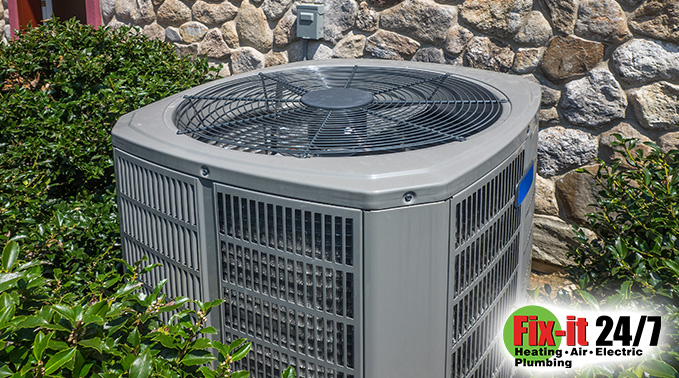How to Clean Heat Pump Condenser Coils
June 8, 2018

While your HVAC technician will most likely include evaporator and condenser coil cleanings as part of their annual maintenance visit, it’s recommended that you clean your outdoor condenser coils more frequently than that.
If you scheduled professional air conditioning maintenance in early spring the way you were supposed to, then it’s been at least a couple of months since it’s received a good cleaning. In just a short period of time, dirt, grass clippings, and debris can quickly gather on the outdoor coils and obstruct airflow.
When the condenser coils get all clogged up, the air conditioner will run longer and work harder. This can lead to expensive repairs and premature breakdowns. Even if the air conditioner cools your home effectively, you’ll be spending more on it.
How an Air Conditioner Works Overview
The AC system produces “cold air” by blowing air over cold evaporator coils. These cold coils absorb heat and then release it to the outside via the refrigerant line. The condenser coils are surrounding by aluminum fins, which are very delicate (more on this later).
The pump, also called a compressor, uses electricity to transfer refrigerant from the evaporator to the condenser and back again in a closed loop.
Basically, the outdoor condenser coil releases heat that was absorbed from the inside of your home by the evaporator.
But, when your condenser coils are covered in leaves, dust, and dirt, it won’t be able to effectively release the heat from the hot refrigerant. A dirty condenser coil costing you money and shortening the lifespan of your heat pump.
How Often Should You Clean Outdoor Condenser Coils?
We are NOT saying that DIY condenser cleanings are a substitute for annual professional AC maintenance. Only a professional will be able to thoroughly clean the unit, which includes removing the top cover and getting inside all the nooks and crannies. (Schedule your professional AC maintenance appointment here.)
We are saying, however, that it’s a good idea to clean condenser coils in addition to the professional cleaning you get in spring. We recommend cleaning your outdoor condenser coil about halfway through the summer and possibly again at the end of the cooling season. This is in addition to professional a professional spring AC tune-up.
You’d be surprised how much dirt and debris can gather on your outdoor unit over a short period of time.
Keep in mind that you should not attempt to clean indoor evaporator coils. Only a professional should clean the evaporator coil.
How to Clean Outdoor Condenser Coils Without Hiring a Pro
Materials:
- Work Gloves
- Goggles
- Work Clothes and Work Boots
- Condenser Coil Cleaner, such as Nu-Brite
- Garden Hose with Low-Pressure Sprayer
- Condenser Coil Fin Comb
Once you’ve gathered your supplies, follow the steps below:
- Turn your thermostat to the “off” position.
- Head outside and locate the outdoor condenser unit.
- Shut off electricity at the outdoor disconnect box. The electrical box should be on the exterior wall right near your condenser unit. If you cannot find the outdoor disconnect box, turn off power to the AC from the main breaker box.
- Put on work gloves.
- Remove large twigs, leaves, and other debris you can remove by hand.
- Inspect the aluminum fins for any damage, If there are a lot bent fins and fin damage, contact a professional. While you can straighten minor fin damage yourself, make sure you have the right tool. Look for aluminum fin combs online or at your local home improvement store. NEVER attempt to straighten aluminum fins with any kind of crude instrument. After straightening the fins as best you can, move on.
- After removing large objects by hand and cleaning debris around the unit, pull the garden hose over to the condenser unit.
- While you don’t necessarily have to use condenser coil cleaner, it’s recommended for the best cleaning. Regardless of if you use condenser coil cleaner or not, always use a low-pressure setting for your garden hose. The aluminum fins are so delicate that a strong blast of water could bend and damage them.
- If you use condenser coil cleaner, follow the directions carefully and use the recommended dilution rates. Add water to the sprayer first, then cleaner.
- Spray the coils with water before applying coil cleaner. This should loosen most of the smaller debris, such as grass, dirt, and dust.
- Apply the coil cleaning solution to the coil. Allow the cleaner to sit for around 5-15 minutes.
- Make sure you are using a low-pressure setting on your garden hose to avoid damaging the fins!
- Thoroughly rinse the cleaner form the condenser coil. Make sure all of the cleaner is rinsed off. Rinse the surrounding area.
- Rinse of the empty coil cleaner bottle, cap it tightly and dispose of properly.
Additional Tips for Condenser Coil Efficiency:
- Make sure your filters are regularly cleaned or replaced.
- Minimize the condenser’s exposure to grass clippings, debris, dirt and all types of sediments such as those that come from the dryer vents, grass/plants, and falling leaves.
- Trim back plants and leave a minimum 2-foot clearance around your unit. If you do choose to enclose the outdoor condenser unit, make sure there is enough airflow and easy access for your technician.
- Consider xeriscaping (dry-scaping) around the outdoor unit, using large stones and hardscaping instead of dirt, grass, and plants.
Clearing away debris and maintaining clean heat pump coils is important for many reasons.
As part of your summer HVAC maintenance, we recommend you inspect and clean your outdoor heat pump. Maintaining clean condenser coils gives your heat pump the airflow necessary to operate smoothly and efficiently.
For professional clean condenser coils and anything else related to HVAC, indoor air quality, or plumbing, contact the experts at Fix-It 24/7.
Service You Can Count On
We came from humble beginnings, having started as just a small family
business. And while we’ve experienced growth, Fix-It 24/7






